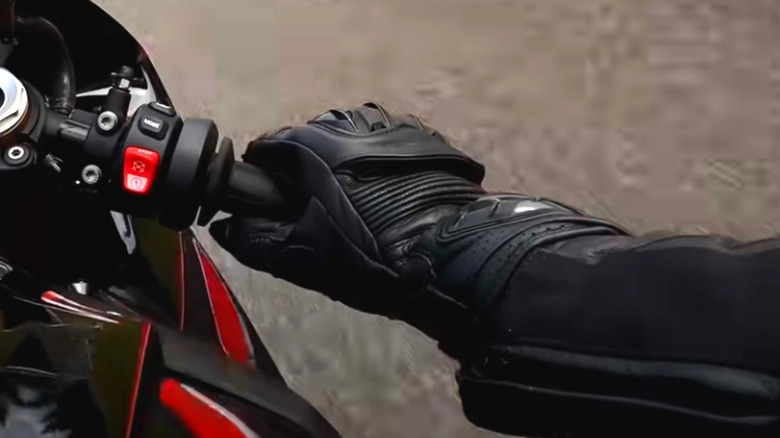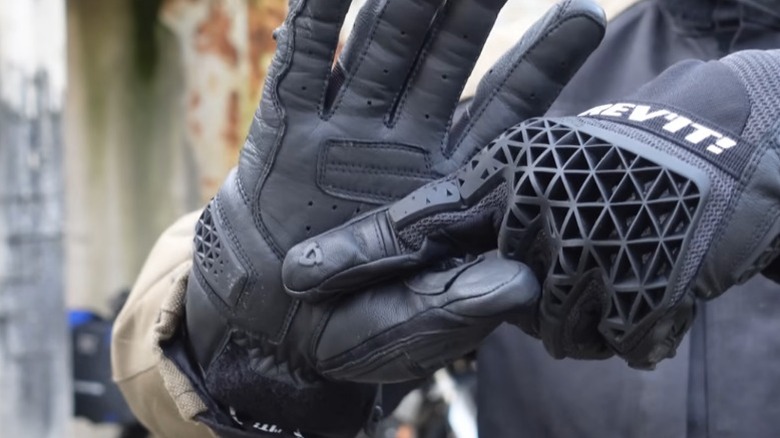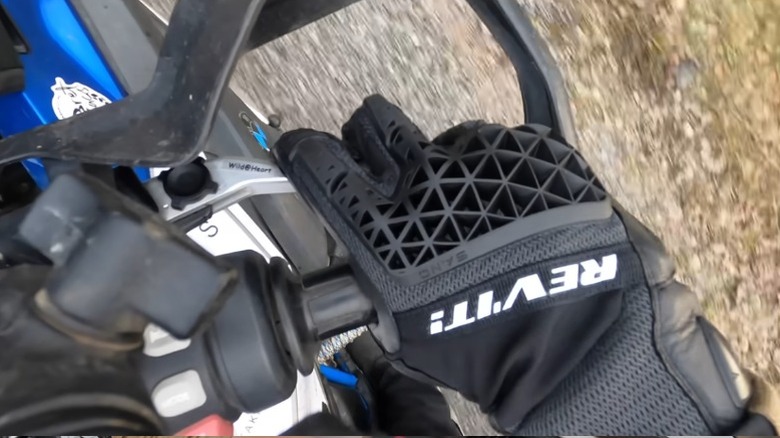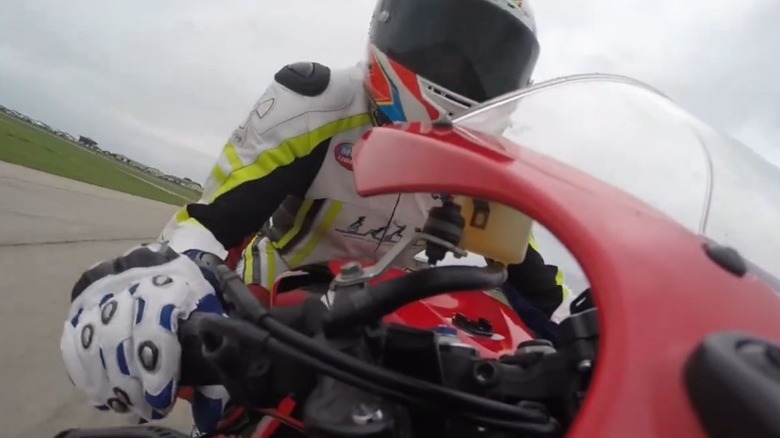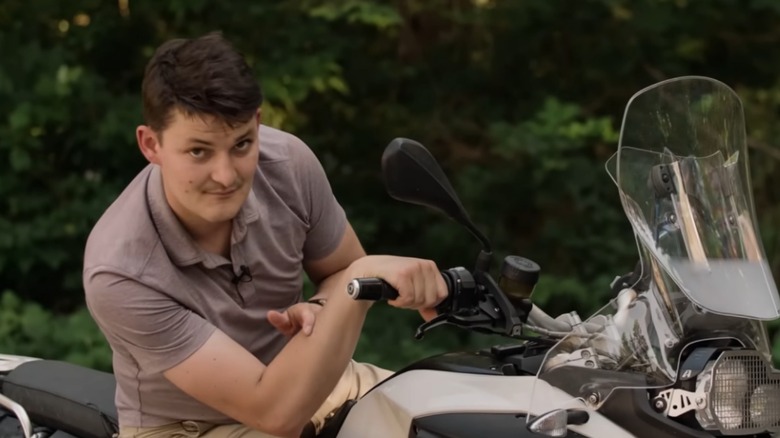Why Every Motorcycle Rider Should Master The 'Screwdriver Grip'
There is a lot to learn when you first start learning to ride a motorcycle. Not only do you have to memorize that nifty little handbook that they give you at the DMV in order to learn the rules of the road, but you also need to master the form and techniques required to ride safely. It's a lot to take in and it can be easy for some of the more nuanced aspects of safe riding to fall through the cracks. Unfortunately, this all-too-often leads riders to develop bad habits that can potentially be dangerous if they find themselves in the wrong situation. Taking the time to learn proper riding safety techniques can mean the difference between a near miss and a trip to the emergency room.
There are a lot of important things that every new motorcycle rider should know, but one aspect of safe riding that doesn't get discussed nearly enough is the way the motorcyclist grips the handles while riding. This might not seem like a big deal when you're learning to properly execute a high-speed turn, or how to correct a motorcycle that has started to slide, but the way a rider holds onto their bike can make a huge difference. Correct hand positioning helps to maintain good posture and tension with the motorcycle. It's also important for emergency situations when riders only have a fraction of a second to react. The 'Screwdriver Grip' is considered one of the best forms for riders to practice. But what is it, and why should every rider master it?
What is the Screwdriver Grip?
Most people who sit down on their motorcycle will instinctively reach out and grab the handlebars and grip them with the bars running parallel to the inside of their knuckles. This might feel comfortable and intuitive, but it isn't the position that offers the most control. For that, you'll need the Screwdriver Grip.
The Screwdriver Grip earned its name by requiring the rider to hold each of the motorcycle handlebars the way that they would hold a screwdriver while they were using it. This means that the part of the handlebar which is closest to the bike's dashboard rests under the first knuckle of the index finger, but the outer section of the handle rests further down the palm, closer to the wrist than the pinky. This cups the handlebar's grip in the groove between the thumb muscle and the distal palm.
When performed properly, this should affect the rider's posture as well. Adjusting the angle of the palms into the Screwdriver Grip forces the rider to keep their elbows further out so that their forearms run parallel with the handlebars. This in turn makes the rider lean further forward as they will be unable to fully extend their arms, adjusting their center of gravity further over the tank.
Why is knowing the Screwdriver Grip important for off-road riders?
Keeping the center of gravity forward, bending the elbows, and shifting weight toward the front of the bike allows for a greater degree of control of the way that the rider's weight influences the balance and turning capabilities of the motorcycle. This is handy, but it can be achieved simply by leaning forward, no matter your grip. One of the biggest benefits of the Screwdriver Grip is that it absorbs and isolates motion by allowing separate movement of the shoulders, elbows, and wrists. This is a must for off-road riding.
Locked wrists and elbows aren't very flexible. They make it so that whatever happens to the bike, happens to the rider as well. This is problematic for off-road riding where you don't have smooth roads to rely on. Keeping your grip angled and your elbows bent creates a sort of shock-absorbing buffer between your torso and your hands. This helps you to lean through the bumps and curves without your body being shifted by the bike itself, allowing for a more fluid range of interaction between the rider and the machine. It also helps ensure that the rider won't accidentally rev the throttle or tug on the brake as they're being rocked by the uneven terrain.
Why is knowing the Screwdriver Grip important for street riders?
When it comes to street riding, the Screwdriver Grip is particularly beneficial for winding roads and racetracks. This is because of the same natural benefits that the grip lends to turning, grip, and riding posture. The biggest weakness of the Screwdriver Grip is probably that it can be quite fatiguing on the rider's back, shoulders, and neck, however. It forces them into a more engaged position, which is good for control, but can put more of a strain on the muscles that are supporting your weight. This makes it difficult for some riders to maintain over long periods, particularly as the hours start to tick by on a cross-country road trip. That said, it's extremely helpful when it comes to wrist fatigue.
@adobomoto Sportbike Screw Driver Grip explained #sportbike #bikelife #motorcyclesoftiktok #screwdrivergrip #motorcycles #motorcycletips
The effect that the Screwdriver Grip has on the rider's positioning may be more dramatic on some bikes than others. This largely depends on the angle of the handlebars that are being gripped. Motorcycles with straighter handlebars (like most dirt bikes) will push the rider further forward, while those with handlebars that are already curved back (like most street bikes) will allow the rider to maintain a more neutral position. Trying to hold these angled grips straight on will force the rider to kink their wrist inward, putting undue strain on the joint and limiting movement and control. The Screwdriver Grip keeps the wrists in a more neutral position that puts less tension on the joints and muscles there.
Why is knowing the Screwdriver Grip important for avoiding hazards?
It doesn't matter if you're riding on the road or a dirt trail, all motorcyclists need to be prepared to encounter something that they might not expect. It could be a car pulling into your lane while you're in their blind spot, an accident, an animal on the road, a downed tree, or a sudden storm. There's no way to know what kinds of hazards you might encounter around the next bend, but it's good to practice how you might react to them if you do. This is why it's never a bad idea to invest in a motorcycle safety course.
The Screwdriver Grip is an excellent position for avoiding obstacles. Slow-speed maneuvers, counterbalancing through sharp turns, and sudden slips all require the rider to have the freedom of movement to react quickly. A straightforward grip places the elbows near the rider's ribcage, limiting movement and thereby limiting the rider's range of mobility. The same freedom of movement that allows riders to shift through bumpy terrain and take high-speed turns with ease is ideal for suddenly needing to alter your course to avoid an obstacle or to pull your bike out of a slide. This is why all riders, even those who prefer straight-forward highway rides, should master the Screwdriver Grip. Preparation is fundamental to safety.
